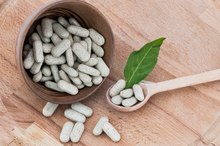Itchy Skin & Liver Problems
Itchy skin, or pruritus, can occur with a wide variety of medical conditions and can be very distressing. Liver diseases with bile obstruction commonly have itching as a symptom, but the reason for itching is not clearly understood. Treatment requires either reversing the bile obstruction or medications to suppress the itch.
If you are experiencing serious medical symptoms, seek emergency treatment immediately.
Cholestatic Liver Disease
Your liver continuously produces bile, which helps your liver remove wastes and helps your intestines absorb dietary fat. Bile is produced in the liver cells, travels out a network of bile ducts through the pancreas and empties into your small intestine. A blockage anywhere along this pathway can slow or stop the flow of bile -- a condition known as cholestasis -- and can lead to increased levels of bile in your bloodstream. Yellowing of the skin and eyes, dark urine and light stools appear as the bile levels climb, often accompanied by widespread itching. Bile flow obstruction can occur inside the liver -- for example, due to hepatitis, cirrhosis, drug use or pregnancy; or it can occur outside the liver, due to gallstones, tumors or inflammation of the pancreas.
- Your liver continuously produces bile, which helps your liver remove wastes and helps your intestines absorb dietary fat.
- Bile flow obstruction can occur inside the liver -- for example, due to hepatitis, cirrhosis, drug use or pregnancy; or it can occur outside the liver, due to gallstones, tumors or inflammation of the pancreas.
Pruritus and Liver Disease
Reasons for Itching Under Skin
Learn More
Widespread, or generalized, itching from liver disease can appear before other signs or symptoms of cholestasis develop. Itching is typically most severe on the palms and soles of the feet, and worse in the late evening and night. No rash or other lesions are present, except when the act of scratching itself damages the skin. Unless liver disease is obviously the cause of itching, your health care provider will perform tests to confirm the diagnosis, including a blood bilirubin level, liver function tests and possibly a liver ultrasound to look for bile duct changes.
- Widespread, or generalized, itching from liver disease can appear before other signs or symptoms of cholestasis develop.
- Unless liver disease is obviously the cause of itching, your health care provider will perform tests to confirm the diagnosis, including a blood bilirubin level, liver function tests and possibly a liver ultrasound to look for bile duct changes.
Explanation for Cholestatic Itching
The reason for generalized itching with liver disease is not well understood, other than the apparent link with obstructed bile flow. Bile salts, chemicals closely related to bile, are deposited in your skin when bilirubin levels rise and have been thought to be the primary cause of itching. Research published in 2012 in the journal "Hepatology" has focused on a protein called autotaxin as the potential cause for cholestatic itching, which may eventually lead to new treatment options 3. Detailed research and explanations are difficult when a symptom like itching occurs with multiple different diseases, is experienced somewhat differently by each individual and responds to different treatments in different cases.
- The reason for generalized itching with liver disease is not well understood, other than the apparent link with obstructed bile flow.
- Research published in 2012 in the journal "Hepatology" has focused on a protein called autotaxin as the potential cause for cholestatic itching, which may eventually lead to new treatment options 3.
Treatment of Itching With Cholestasis
Liver Itch Detox
Learn More
Resolving the cause of bile flow obstruction is the best treatment for itching with liver disease, but when this isn’t immediately possible several medications can help relieve the itch. Cholestyramine is used most often, and works by binding bile salts in your intestines so they are excreted rather than reabsorbed back into the bloodstream. Rifampicin, an antibiotic, causes an increase in liver metabolism of bile and other chemicals, and relieves itching in some people. Drugs that block opioid receptors in the body also sometimes help, suggesting that your body’s own endorphins may play a role in pruritus. Stopping any drugs that can further harm the liver, such as alcohol, is also recommended.
- Resolving the cause of bile flow obstruction is the best treatment for itching with liver disease, but when this isn’t immediately possible several medications can help relieve the itch.
- Cholestyramine is used most often, and works by binding bile salts in your intestines so they are excreted rather than reabsorbed back into the bloodstream.
Related Articles
References
- The Merck Manuals Online Medical Library: Cholestasis
- “Pruritus”; Laurent Misery, Sonja Stander, Editors; 2010
- Hepatology: Serum Autotaxin Is Increased in Pruritus of Cholestasis, but Not of Other Origin, and Responds to Therapeutic Interventions
- Chan J, Vandeberg JL. Hepatobiliary transport in health and disease. Clin Lipidol. 2012;7(2):189-202. doi:10.2217/clp.12.12
- Alhmada Y, Selimovic D, Murad F, et al. Hepatitis C virus-associated pruritus: Etiopathogenesis and therapeutic strategies. World J Gastroenterol. 2017;23(5):743–750. doi:10.3748/wjg.v23.i5.743
- "How Does the Liver Work?" National Institutes of Health.
- MedlinePlus. Bethesda (MD): National Library of Medicine (US). "Bile."
- MedlinePlus. Bethesda (MD): National Library of Medicine (US). "Gallbladder Diseases."
- Merck Manual. "Overview of Biliary Function." Atenodoro R. Ruiz, Jr., MD.
Resources
Writer Bio
Fred Schubert is a retired physician with both writing and teaching experience during his professional career, reaching back to 1983. Since 2009 he has been writing periodic articles on general science for his local newspaper, "The Dalles Chronicle." Schubert holds a Bachelor of Arts degree in biology and a M.D. from the Oregon Health Sciences University.








